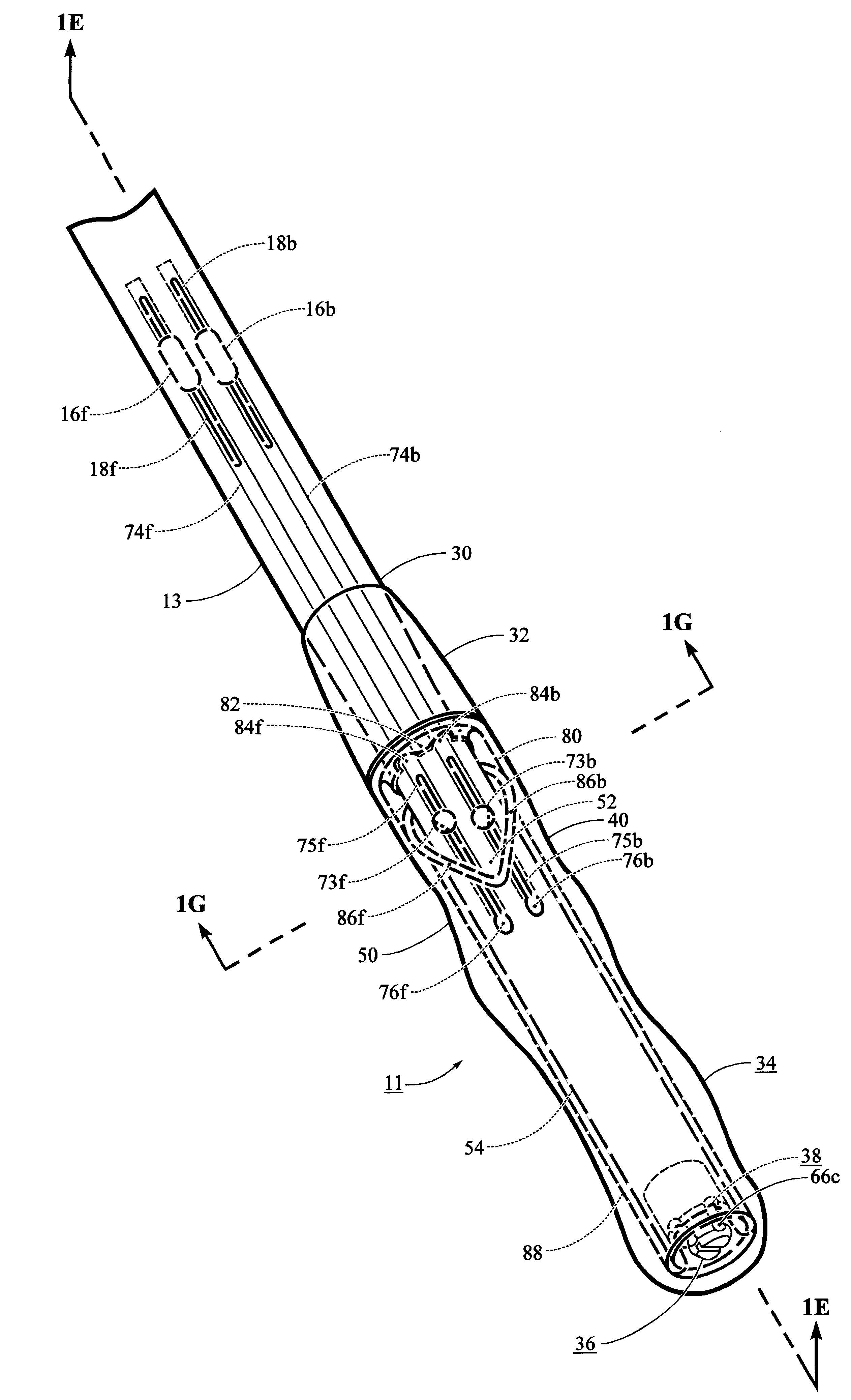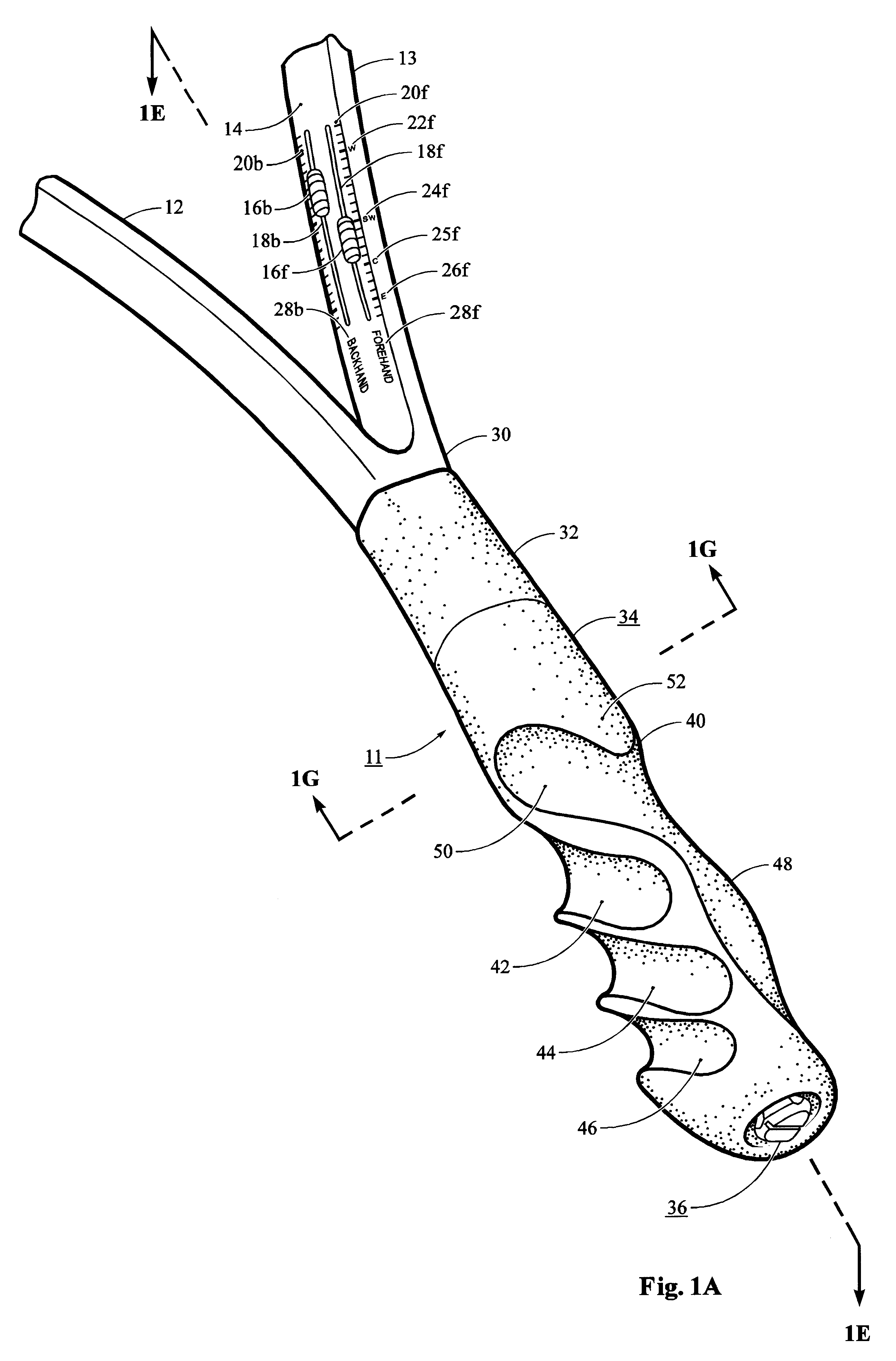However, rotatable handle grips that can be locked in only a limited number of predetermined positions, or that cannot be adjusted easily and instantaneously during play, are inefficacious because they limit not only the types of shots a player can make but the quality of play in general.
If a user wishes to rotate the tool in the opposite direction, he must slide or twist a setting switch prior to use, a
time consuming and bothersome procedure.
Manufacture and
assembly of the numerous
moving parts is relatively complex, resulting in production costs far above that of conventional stationary handle grip screwdrivers.
This involved a cumbersome and time-consuming process; a user was required to loosen a nut at the base of the handle, disengage a toothed mechanism, estimate where the desired setting might be, reengage the teeth, and finally retightening the base nut Consequently, this handle grip mechanism could not provide any benefit if applied to a tennis racquet since the user would be unable to rotate the handle grip to different positions during play.
Marsh's handle could not provide a ratcheting effect, or selectively transfer torque, thereby making it equally non-beneficial for screwdrivers.
Unfortunately, the spring tension required to prevent
axial rotation of the racquet during off-center shots was enormous; this made quick handle grip position changes during play nearly impossible.
Hanks' handle grip was also complicated to operate.
Since the handle grip was normally in a locked position, if the user applied rotational force to the handle grip prior to depressing the
thumb tab, the mechanism could jam; even worse, the dog-pin or opposing parts could shear or bend.
Likewise, if the user did not release the
thumb tab at, or immediately prior to the desired hole setting while rotating the handle grip, it could lock in the wrong position, or not even lock at all.
Without such control the racquet-face will not be at the correct angle relative to the ground at the moment of
impact with a ball during a tennis
stroke.
Adding more holes would have confused the user; there was no way to quickly and easily distinguish among even the few settings which were provided.
Too many holes would have also greatly increased the chance of part failure due to shear; the greater the number of holes, the smaller each hole would need to be to remain separated, and the thinner the dog-pin would need to be.
Finally, Hanks' mechanism did not address the extremely important factor of user compatibility.
When gripping the handle in such an awkward and unnatural manner, it is extremely difficult to maintain a firm grip and control of the racquet when hitting a
tennis ball.
Furthermore, a player could inadvertently unlock the handle grip from its setting; there is a natural tendency to squeeze the handle grip of a tennis racquet more firmly at the moment the racquet impacts the ball.
If the mechanism for changing grip positions is cumbersome,
time consuming, unreliable, and distracting to use, it is not appropriate for use in a game which requires intense concentration and nearly instantaneous grip changes.
Hanks' tennis racquet handle grip mechanism was also inappropriate for performing a ratcheting effect on screwdrivers.
The handle grip had only two settings--forehand and backhand As mentioned earlier, a handle grip that provides only a limited number of predetermined positions is inefficacious.
Adding many positions would not be possible; the mechanism necessitates a large rotational displacement between positions in order to prevent part failure due to shear.
Furthermore, the user would be unable to easily and quickly distinguish between positions, and accurately reengage the locking peg in a desired slot.
The mechanism increased
response time during play and was also susceptible to jamming.
This extra motion increased the amount of time needed to change from one grip position to another.
In many circumstances during play, the grip change could not be performed in time to hit the ball.
If the player, in his haste, attempted to rotate the handle grip prior to "unlocking" it, the mechanism could jam.
As a consequence, the user experienced uncomfortable vibration from the handle grip when hitting a
tennis ball.
Still another barrier to the use of Heath's grip was the extreme awkwardness and discomfort it presented to players who use a "two-handed grip".
As with other racquet handle grips, Heath's handle grip was also inappropriate for performing a ratcheting effect on screwdrivers.
As with Heath's handle grip, this method was both time consuming and cumbersome because it forced the user to effectuate both longitudinal and rotational movement to change settings.
Additionally, the nature of the tooth mechanism with its finite number of teeth necessitated a large racquet head
angular displacement between each setting which, as mentioned previously, is not practicable for racquet applications.
This grip mechanism also suffered from vibration during use, primarily caused by the spring.
In the form presented, Melby's handle grip would be ineffective for producing a ratcheting effect on screwdrivers.
Consequently, Carbonetti's handle grip experienced the same limitations found in the handle grips of Melby and Heath.
U.S. Pat. No. 4,943,058 to Carbonetti (1990), a tennis racquet with a fixed grip and moveable frame, utilized the same mechanisms as Melby's
golf club with rotatable handle, and resulted in the same limitations.
U.S. Pat. No. 4,033,593 to Erhart (1977), a tennis racquet with a slip
clutch handle, did not permit the user to quickly rotate the handle to desired grip positions and prevent relative rotation between the handle grip and the racquet Rather, the mechanism merely acted as a rotary
shock absorber; rotational movement of the handle grip occurred when the playing ball struck on or near the frame at either side of the racquet head.
As with other racquet handle grips, Erhart's handle grip was also inappropriate for performing a ratcheting effect on screwdrivers.
Clearly, the mechanism could not be applied to racquet handle grips or the like; there would be no way to prevent rotation of the racquet relative to the handle grip during play.
Although a ratcheting effect could be accomplished with this handle grip, there were limitations to its use; i.e. the tool had to encounter resistance when longitudinal force was applied to the handle grip.
Also, when used to screw or unscrew long bolts, the user experienced undue effort; prior to each rotation the user was required to overcome the force of the spring.
Such a motion repeated many times could be fatiguing as well as time consuming.
 Login to View More
Login to View More  Login to View More
Login to View More 


